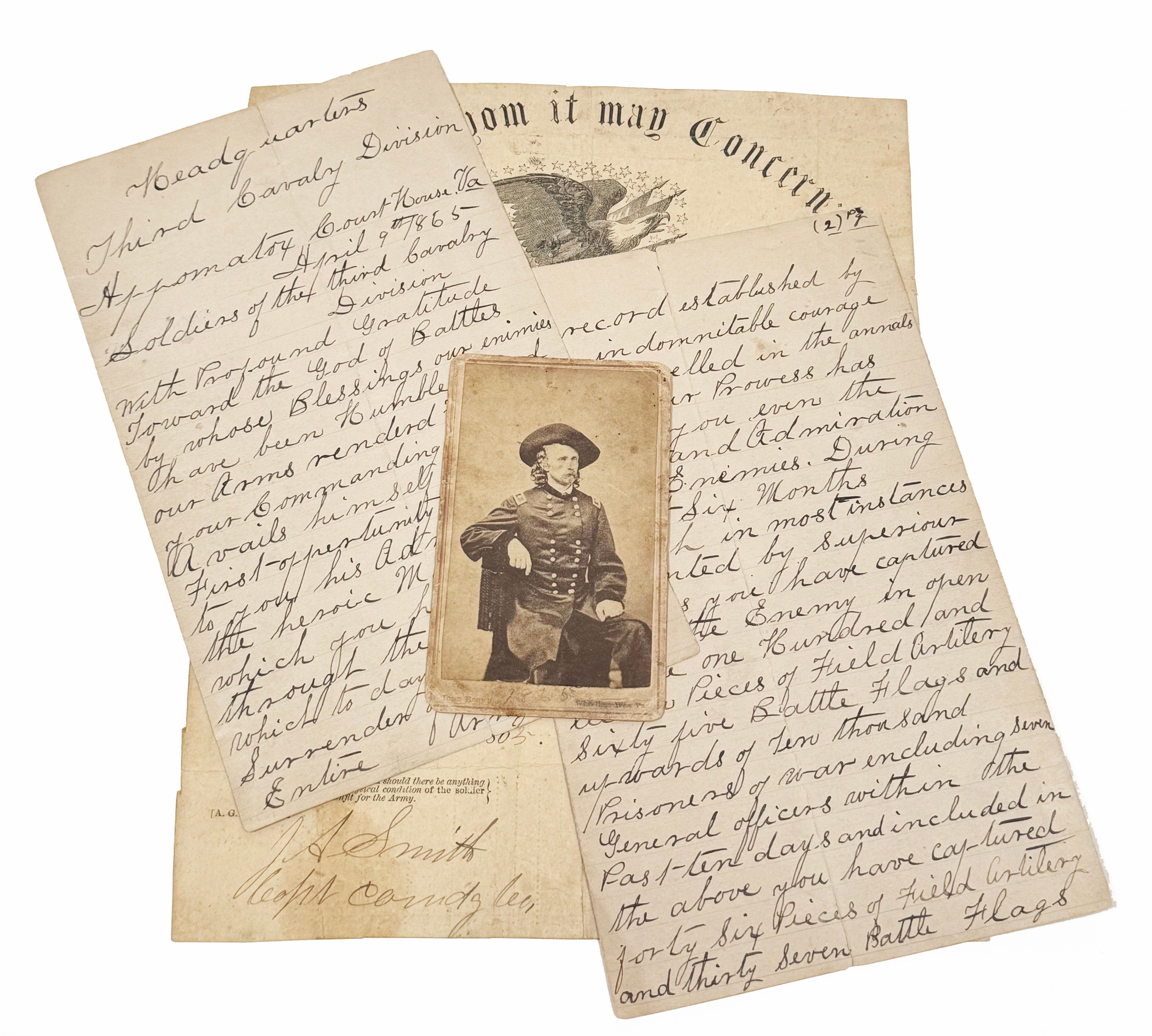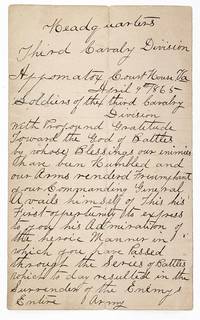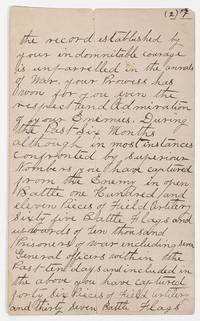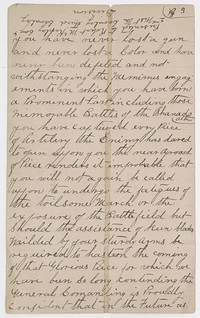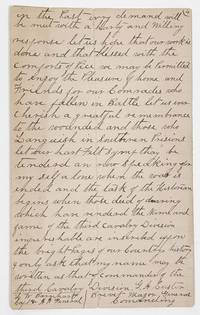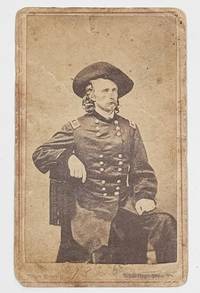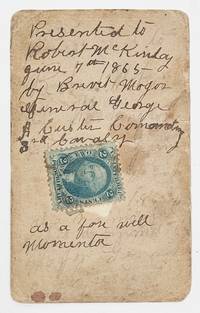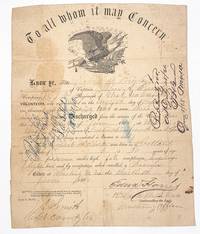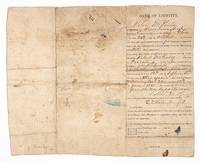Manuscript of Congratulatory Order to the Third Cavalry Division; Custer's Carte De Visite; Soldier's Discharge Papers
- SIGNED manuscript
- Appomattox, Virginia: np, 1865
Appomattox, Virginia: np, 1865. first. manuscript. Very Good. MANUSCRIPT PRESENTATION COPY OF A CLASSIC CIVIL WAR DOCUMENT: Custer’s Congratulatory Order, a farewell message to his beloved troops of the Third Cavalry Division. Dated April 9, 1865, the date of Lee’s surrender at the Appomattox Court House. In the hand of Captain Levant W. Barnhart, Acting Assistant Adjutant General to Custer, inscribed to Private Robert McKinley of the 2nd West Virginia Cavalry, Third Cavalry Division. With Carte de Visite of Custer and discharge papers of McKinley. General Custer was present at Appomattox Court House for the momentous occasion of Lee’s surrender on April 9, 1865, and on the same day he wrote a stirring “thank-you” letter to his troops. Custer’s Congratulatory Order "like Lee's farewell to the Army of Northern Virginia, has become a classic in the annals of American military literature, and it stands as a testimonial to the character of a man who never forgot his soldiers at the moment of his greatest glory and renown” (Urwin, Custer Victorious).
This is an exceptionally rare manuscript copy of Custer's Congratulatory Order. The address itself—issued on the day of General Lee's surrender—was printed in broadside form shortly thereafter (at least after April 15). Unlike the printed broadside, which was distributed for general morale or public notice, this manuscript, in the hand of Custer’s assistant L.W. Barnhart, was apparently created for a private presentation, almost certainly written in the day of, or the days following the surrender as a token of gratitude or distinction.
The four-page, two-leaf manuscript lacks formality, with numerous spelling errors, a hurried hand and simple stationery; it was seemingly dashed off on what paper was available near a battlefield at wartime. Moreover, the inscription “Presented to Robert McKinley” is written upside-down, suggesting it was composed after Barnhart finished his transcription of the address and folded the two sheets of paper. Likewise, at the end of the address, the words “Brevet, Major General Comanding [sic]” for Custer are written in a cramped corner of the paper in a darker ink, seemingly added in later. Custer was not granted the title “Brevet Major General” until April 15 but since it appears that this was added later in different ink it is possible, or even likely, that the manuscript was written before April 15, possibly even on the day of surrender.
The manuscript, written in a strong brown ink on blue-lined wove paper, is headed "Headquarters / Third Cavalry Division / Appomattox Court House. Va. / April 9, 1865" and signed (not in Custer’s hand) at the conclusion: "G. A. Custer / Brevet Major General Commanding." At bottom left is the formal attribution: "L.W. Barnhart, Capt & A.A. General." On the third page, in the same hand, is the presentation inscription: "Presented to Robert McKinley, Com. 4, 2nd West Va. Cavalry Third Cavalry Division."
Private Robert McKinley:
Given the effort in handwriting the address, and the scarcity of these types of addresses in manuscript form, one might expect only high ranking figures to receive such gifts. However, in this case, the recipient is not a high ranking soldier or politician, but a 20-year-old Scottish-born farmer, specifically Private Robert McKinley who served in Company I, 2nd West Virginia Volunteer Cavalry, part of Custer's Third Cavalry Division, who were present at the time of the surrender of General Robert E. Lee’s army to General Ulysses S. Grant at the Appomattox Court House on April 9, 1865. McKinley was officially mustered out in Wheeling, West Virginia on June 30, 1865 (as the included discharge paper shows). Although only a private, McKinley was singled out to receive a manuscript copy of Custer’s farewell—a testament perhaps to his presence at headquarters, his conduct in the field, or a personal connection to Barnhart or Custer himself. The accompanying carte de visite of Custer, with the inscription in a different hand than the address (likely McKinley’s), “Presented to Robert McKinley June 7th 1865-by Brevet Major General George A Custer Commanding 3rd Cavalry as a fare well memento” suggests a moment of formal presentation, possibly timed with his discharge on the 13th of June, 1865.
Levant W. Barnhart
Levant W. Barnhart, who scribed the address, was barely twenty-one at the time of the surrender, served as Custer’s adjutant during the final months of the war. The document is executed in Barnhart’s careful script, with variant spellings and occasional idiosyncratic phrasing, suggesting its status as a field copy rather than a later polished commemorative draft.
Our Theory:
A few questions remain about McKinley’s version of the address. Why would a commemorative manuscript version of the speech be so hastily written? Why is the inscription upside down? Why is Custer’s new title of brevet awkwardly crammed into the corner of the paper? And did this manuscript come before or after the published broadside?
Our theory is that Barnhart wrote a handful of copies of the address on April 9 or immediately after. They were hastily written by the battlefield where resources were scarce so it is not written on formal stationery but rather on simple lined paper. Barnhart did not know to which of his most valued men Custer would like to present these precious manuscripts so he did not initially inscribe them. In the following days, we imagine, Barnhart finally had a chance to ask Custer whom he would like to receive these spectacular gifts. Custer chose one of his most valued soldiers – Private Robert McKinley. It was only then that Barnhart wrote out “Presented to Robert McKinley, Com. 4, 2nd West Va. Cavalry Third Cavalry Division” on one of the already folded handful of copies. Furthermore, we believe Barnhart may have added Custer’s new title of Brevet, at this same moment, dating the inscription and the added title (but not the manuscript text) to after April 15, but before June 7 when the items were presented to Robert McKinley.
What Makes This Item So Remarkable?
Even the printed broadside of Custer’s “Farewell Address” is scarce. This handwritten version of the speech appears to be one of only a handful – perhaps only two – surviving manuscripts. We have not been able to locate another such presentation manuscript; only one other manuscript copy of an unknown date and provenance. And its recipient, a private, not a general or a politician, highlights something remarkable about not only the recipient, but Custer himself. Custer led from the front of the battlefield. He fought with his men. His offering such a limited item to a humble Scottish-born private seems fitting for Custer’s military style.
––––
Address offered together with Robert McKinley's discharge papers and a carte de visite of General Custer inscribed on the verso: “Presented to Robert McKinley June 7th 1865 by Brevet Major General George A. Custer, Commanding 3rd Cavalry - as a fare well momento [sic].”
Manuscript: 4 pages on 2 sheets of 4.75 x 8 inch lined paper. Page numbers in top right corners, though 4 is on the back of 1, and 3 on the back of 2. Expected folds, a little early reinforcement adhesive evident on page 3 fold. Ink very strong and legible. Carte de visite: 2.5 x 4 in. Card stock. Light creases, bumped corners, general soiling. Two-cent stamp affixed to verso. Discharge paper: 7.75 x 9.75 in. Printing and handwritten text with eagle engraving at head. Usual folds, some soiling.
A unique and highly evocative survival of the Civil War—uniting one of the most charismatic Union commanders, one of the most consequential dates in American history, and one ordinary soldier whose name survives precisely because he received this extraordinary gift.
This is an exceptionally rare manuscript copy of Custer's Congratulatory Order. The address itself—issued on the day of General Lee's surrender—was printed in broadside form shortly thereafter (at least after April 15). Unlike the printed broadside, which was distributed for general morale or public notice, this manuscript, in the hand of Custer’s assistant L.W. Barnhart, was apparently created for a private presentation, almost certainly written in the day of, or the days following the surrender as a token of gratitude or distinction.
The four-page, two-leaf manuscript lacks formality, with numerous spelling errors, a hurried hand and simple stationery; it was seemingly dashed off on what paper was available near a battlefield at wartime. Moreover, the inscription “Presented to Robert McKinley” is written upside-down, suggesting it was composed after Barnhart finished his transcription of the address and folded the two sheets of paper. Likewise, at the end of the address, the words “Brevet, Major General Comanding [sic]” for Custer are written in a cramped corner of the paper in a darker ink, seemingly added in later. Custer was not granted the title “Brevet Major General” until April 15 but since it appears that this was added later in different ink it is possible, or even likely, that the manuscript was written before April 15, possibly even on the day of surrender.
The manuscript, written in a strong brown ink on blue-lined wove paper, is headed "Headquarters / Third Cavalry Division / Appomattox Court House. Va. / April 9, 1865" and signed (not in Custer’s hand) at the conclusion: "G. A. Custer / Brevet Major General Commanding." At bottom left is the formal attribution: "L.W. Barnhart, Capt & A.A. General." On the third page, in the same hand, is the presentation inscription: "Presented to Robert McKinley, Com. 4, 2nd West Va. Cavalry Third Cavalry Division."
Private Robert McKinley:
Given the effort in handwriting the address, and the scarcity of these types of addresses in manuscript form, one might expect only high ranking figures to receive such gifts. However, in this case, the recipient is not a high ranking soldier or politician, but a 20-year-old Scottish-born farmer, specifically Private Robert McKinley who served in Company I, 2nd West Virginia Volunteer Cavalry, part of Custer's Third Cavalry Division, who were present at the time of the surrender of General Robert E. Lee’s army to General Ulysses S. Grant at the Appomattox Court House on April 9, 1865. McKinley was officially mustered out in Wheeling, West Virginia on June 30, 1865 (as the included discharge paper shows). Although only a private, McKinley was singled out to receive a manuscript copy of Custer’s farewell—a testament perhaps to his presence at headquarters, his conduct in the field, or a personal connection to Barnhart or Custer himself. The accompanying carte de visite of Custer, with the inscription in a different hand than the address (likely McKinley’s), “Presented to Robert McKinley June 7th 1865-by Brevet Major General George A Custer Commanding 3rd Cavalry as a fare well memento” suggests a moment of formal presentation, possibly timed with his discharge on the 13th of June, 1865.
Levant W. Barnhart
Levant W. Barnhart, who scribed the address, was barely twenty-one at the time of the surrender, served as Custer’s adjutant during the final months of the war. The document is executed in Barnhart’s careful script, with variant spellings and occasional idiosyncratic phrasing, suggesting its status as a field copy rather than a later polished commemorative draft.
Our Theory:
A few questions remain about McKinley’s version of the address. Why would a commemorative manuscript version of the speech be so hastily written? Why is the inscription upside down? Why is Custer’s new title of brevet awkwardly crammed into the corner of the paper? And did this manuscript come before or after the published broadside?
Our theory is that Barnhart wrote a handful of copies of the address on April 9 or immediately after. They were hastily written by the battlefield where resources were scarce so it is not written on formal stationery but rather on simple lined paper. Barnhart did not know to which of his most valued men Custer would like to present these precious manuscripts so he did not initially inscribe them. In the following days, we imagine, Barnhart finally had a chance to ask Custer whom he would like to receive these spectacular gifts. Custer chose one of his most valued soldiers – Private Robert McKinley. It was only then that Barnhart wrote out “Presented to Robert McKinley, Com. 4, 2nd West Va. Cavalry Third Cavalry Division” on one of the already folded handful of copies. Furthermore, we believe Barnhart may have added Custer’s new title of Brevet, at this same moment, dating the inscription and the added title (but not the manuscript text) to after April 15, but before June 7 when the items were presented to Robert McKinley.
What Makes This Item So Remarkable?
Even the printed broadside of Custer’s “Farewell Address” is scarce. This handwritten version of the speech appears to be one of only a handful – perhaps only two – surviving manuscripts. We have not been able to locate another such presentation manuscript; only one other manuscript copy of an unknown date and provenance. And its recipient, a private, not a general or a politician, highlights something remarkable about not only the recipient, but Custer himself. Custer led from the front of the battlefield. He fought with his men. His offering such a limited item to a humble Scottish-born private seems fitting for Custer’s military style.
––––
Address offered together with Robert McKinley's discharge papers and a carte de visite of General Custer inscribed on the verso: “Presented to Robert McKinley June 7th 1865 by Brevet Major General George A. Custer, Commanding 3rd Cavalry - as a fare well momento [sic].”
Manuscript: 4 pages on 2 sheets of 4.75 x 8 inch lined paper. Page numbers in top right corners, though 4 is on the back of 1, and 3 on the back of 2. Expected folds, a little early reinforcement adhesive evident on page 3 fold. Ink very strong and legible. Carte de visite: 2.5 x 4 in. Card stock. Light creases, bumped corners, general soiling. Two-cent stamp affixed to verso. Discharge paper: 7.75 x 9.75 in. Printing and handwritten text with eagle engraving at head. Usual folds, some soiling.
A unique and highly evocative survival of the Civil War—uniting one of the most charismatic Union commanders, one of the most consequential dates in American history, and one ordinary soldier whose name survives precisely because he received this extraordinary gift.


